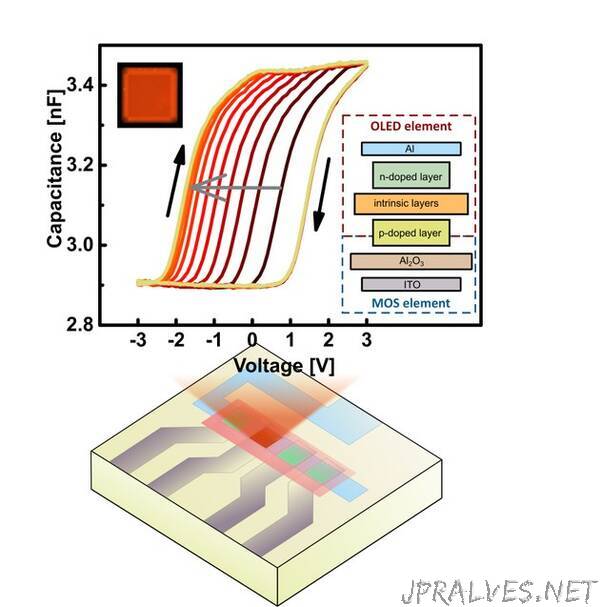
“Scientists of the Dresden Integrated Center for Applied Physics and Photonic Materials (IAPP) and the Center for Advancing Electronics Dresden (cfaed) at TU Dresden have developed a novel storage technology based on the combination of an organic light-emitting diode (OLED) and an insulator. This device allows reading the stored information optically as well as electrically. Moreover, the information can be added in portions - thus several storage states can be mapped in one device. The results have now been published in the renowned journal “Advanced Functional Materials”.
Another novelty was related to the measurements in the test series: They were carried out exclusively using the innovative “SweepMe!” measuring software, which was developed by an IAPP / cfaed start-up of the same name.
This story began a few way back in 2015. Two cfaed scientists, both experts in the field of organic electronics, were on their way to a conference in Brazil which included a long bus ride to the venue Porto de Galinhas. Plenty of time to talk. And so it happens that one of the two - Prof. Stefan Mannsfeld (Chair of Organic Devices, cfaed / IAPP) - shared the idea with the other one - Dr. Axel Fischer (Chair of Organic Semiconductors, IAPP) – that had kept him busy for a while already:
The combination of a conventional organic light-emitting diode (OLEDs) with an insulator layer would have to result in a storage unit due to the specific physical effects of the materials used, which could be written on and read out using both light and electrical signals: a misappropriated use of the OLED technology so to speak. As it turned out, the two were a perfect match – Dr. Fischer confirmed that the necessary technologies and experience were already available at the IAPP - and so the investigation of this idea was only a matter of time. Yichu Zheng at Prof. Mannsfeld’s chair was a suitable candidate to dedicate her doctoral thesis to this topic.
Storing and reading - with light and electricity
The results of this work are available now and have just been published in the journal Advanced Functional Materials. The scientists describe a new type of programmable organic capacitive memory, which is a combination of an OLED and a MOS capacitor (MOS = metal oxide semiconductor). The storage unit called “pinMOS” is a non-volatile memcapacitor with high repeatability and reproducibility. The special feature is that pinMOS is able to store several states, since charges can be added or removed in controllable amounts. Another attractive feature is that this simple diode-based memory can be both electrically and optically written to and read from. Currently, a lifetime of more than 104 read-write erase cycles is achieved, and the memory states can be maintained and differentiated over 24 hours. The results show that the pinMOS memory principle as a reliable capacitive storage medium is promising for future applications in electronic and photonic circuits such as neuromorphic computers or visual storage systems. The co-authors of the Weierstraß Institute Berlin (WIAS) were able to contribute to the precise interpretation of the functional mechanism by performing drift diffusion simulations.
A diode-capacitor memory was first presented in 1952 by Arthur W. Holt at an ACM conference in Canada, but only now this concept is being revived by the use of organic semiconductors, since all functions of a discrete connection of diodes and capacitor can be integrated into a single memory cell.
Measuring with SweepMe! - innovative approach for the laboratory
All measurements within this study were performed with the new laboratory measurement software “SweepMe! This software has been developed by a start-up, which is a spin-off from TU Dresden. The physicists Axel Fischer and Felix Kaschura who received their PhD’s from TUD founded SweepMe! in 2018 at the IAPP.
This study proved how versatile SweepMe! can be. Whether the measurement of voltage-dependent and time-dependent capacitances, the creation of current-voltage characteristics, the combination of signal generator and oscilloscope or the processing of images from an industrial camera - everything was implemented with only this one software. Even sophisticated parameter variations, which would normally require considerable programming effort, could be implemented in a very short time. Since October 2019 SweepMe! is available worldwide free of charge.
Paper title: Introducing pinMOS Memory: A Novel, Nonvolatile Organic Memory Device
DOI: 10.1002/adm.201907119
Authors: Yichu Zheng, Axel Fischer, Michael Sawatzki, Duy Hai Doan, Matthias Liero, Annegret Glitzky, Sebastian Reineke, Stefan C. B. Mannsfeld
Medium: Advanced Functional Materials, published November 07, 2019
The study is a cooperation of TU Dresden (Dresden Integrated Center for Applied Physics and Photonic Materials – IAPP & Center for Advancing Electronics Dresden – cfaed) and Weierstraß Institute Berlin (WIAS).”
